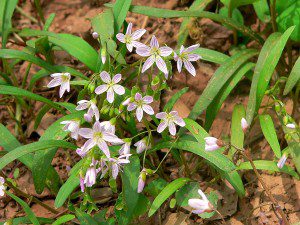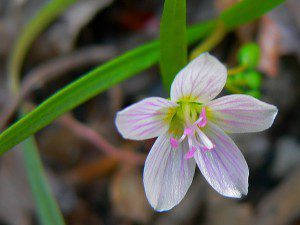Plant Sale Profile: Claytonia virginica
 Claytonia virginica is a member of the family Montiaceae (formally Portulacaceae – in case you’re looking for information regarding this plant in an older reference). The genus is named for John Clayton, 1694-1773, who was a Colonial plant collector and tobacco farmer in Virginia. Common names are Spring Beauty, Virginia Spring Beauty, Eastern Spring Beauty. This plant is native to all but a handful of counties in Virginia. It is native to the piedmont.
Claytonia virginica is a member of the family Montiaceae (formally Portulacaceae – in case you’re looking for information regarding this plant in an older reference). The genus is named for John Clayton, 1694-1773, who was a Colonial plant collector and tobacco farmer in Virginia. Common names are Spring Beauty, Virginia Spring Beauty, Eastern Spring Beauty. This plant is native to all but a handful of counties in Virginia. It is native to the piedmont.
Naturally found in well-drained floodplain forests, mesic and dry-mesic upland forests, and old fields; most characteristic of, but not restricted to, base-rich soils. I have seen flourishing at the edge of a gravel road. The preference is dappled sunlight during the spring, moist to slightly dry conditions, and a rich loamy soil with abundant organic matter. Claytonia virginica is happy in woodland conditions. Both the flowers and foliage fade away by mid-summer. An early bloomer (March to April), this small native plant gets two to six inches tall. The small flower is only 1/2 to 3/4 inch across and it has grass like leaves.  The star like white flower has pink stripes. Disease and insect damage is rare. Claytonia virginica spreads by reseeding itself; sometimes it forms rather loose colonies of plants. It also wilts easily once picked so enjoy it in the garden. The flowers open up on warm sunny days, and close during cloudy weather or at night.
The star like white flower has pink stripes. Disease and insect damage is rare. Claytonia virginica spreads by reseeding itself; sometimes it forms rather loose colonies of plants. It also wilts easily once picked so enjoy it in the garden. The flowers open up on warm sunny days, and close during cloudy weather or at night.
Pollinators that are attracted to Claytonia virginica include various bees and flies. Occasionally butterflies and skippers visit seeking nectar. The corms are eaten by small mammals including the Eastern Chipmunk. Although not a favorite of deer, they do sometimes eat it.
Claytonia virginica is edible by humans. The small size of this plant doesn’t make it practical as a forage plant, however the entire plant is edible. For more information about eating Claytonia virginica go to: http://www.eattheweeds.com/spring-beauty/
